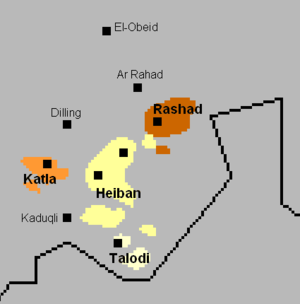Talodi–Heiban languages
| Talodi–Heiban | |
|---|---|
| Geographic distribution | Nuba Hills, Sudan |
| Linguistic classification | Niger–Congo?
|
| Subdivisions | |
| Glottolog | None narr1279 (Talodi) heib1242 (Heiban) |
 | |
The Talodi–Heiban languages are a proposed branch of the hypothetical Niger–Congo family, spoken in the Nuba Mountains of Sudan. The Talodi and Heiban languages are thought to be distantly related by Dimmendaal,[1] though Glottolog 4.4 does not accept the unity of Talodi–Heiban pending further evidence.[2]
Classification
[edit]Roger Blench (2016) notes that the Talodi and Heiban branches share many typological similarities, but few lexical similarities. Blench (2016) considers Talodi and Heiban to each be separate, independent Niger-Congo branches that had later converged due to mutual contact.
Talodi and Heiban had each constituted a group of the Kordofanian branch of Niger–Congo that was posited by Joseph Greenberg (1963); Talodi has also been called Talodi–Masakin, and Heiban has also been called Koalib or Koalib–Moro. Roger Blench notes that the Talodi and Heiban families have the noun-class systems characteristic of the Atlantic–Congo core of Niger–Congo, but that the Katla languages (another putative branch of Kordofanian) have no trace of ever having had such a system, whereas the Kadu languages and some of the Rashad languages appear to have acquired noun classes as part of a Sprachbund, rather than having inherited them. He concludes that the Kordofanian languages do not form a genealogical group, but that Talodi–Heiban is core Niger–Congo, whereas Katla and Rashad form a peripheral branch (or perhaps branches) along the lines of Mande. The Kadu languages may be Nilo-Saharan.
Talodi–Heiban
|
| ||||||
- † = extinct
Lafofa (Tegem), sometimes classified as a divergent Talodi language, has a different set of cognates with other Niger–Congo and has been placed in its own branch of Niger–Congo.
Norton & Alaki (2015)
[edit]Norton & Alaki (2015: 76, 126)[3] classify the Talodi languages as follows. Proto-Talodi, Proto-Lumun-Torona, and Proto-Narrow Talodi have also been reconstructed by Norton & Alaki (2015).
| Talodi | |
Relationship
[edit]Lexical correspondences between Proto-Heiban and Proto-Talodi according to Blench (2016):[4]
| Gloss | Proto-Heiban | Proto-Talodi |
|---|---|---|
| belly | *k-aaRi / ɲ- | *C-a[a]rәk / kә- |
| dry | *Ø-undu / k- | *Øandu[k] / t~k |
| ear | *k-ɛɛni / ɲ- | *k-ɛ[ɛ]nu / Ø- |
| fire | *iiga | *t̪-ɪ[ɪ]k / ḷ- |
| give | *N-d̪ɛ-d̪í | *N-d̪í |
| guts | *t̪-y / n̪-u | *t-u[u]k / n- |
| hear | *g-aani / n- | *g-eenu / w- |
| hole | *li-buŋul / ŋu- | *t-ʊbʊ / n- |
| horn | *l-uuba / ŋ- | *t~C-uubʊk / n~m- |
| left side | *t̪-agur | *Ø-ʊgʊlɛ / C- |
| name | *C-iriɲ | *k-әḷәŋaŋ / N~Ø- |
| pull | *uud̪i | *aadu |
| red | *k-ʊʊrɪ | *ɔɔɽɛ |
| rope | *d̪-aar / ŋw- | *t̪-ɔ[ɔ]ḷәk / ḷ- |
| small | *-itti(ɲ) | *ɔt̪t̪ɛ(ŋ) |
| star | *l-ʊrʊm / ŋ- | *C-ɔ[ɔ]d̪ɔt̪ / m |
| stone | *k-adɔl / y- | *p-әd̪ɔk / m |
| tongue | *d̪-iŋgәla / r- | *t̪-ʊlәŋɛ / ḷ- |
| tooth | *l-iŋgat / y- | *C-әɲi[t] / k- |
| wing | *k-ibɔ / ʧ- | *k-ʊbɪ / Ø- |
Noun class prefix comparison between Proto-Heiban and Proto-Talodi according to Blench (2016):[4]
| Noun class | Proto-Heiban | Proto-Talodi |
|---|---|---|
| Persons | *kʷ,gʷ-/l- | *p,b-/Ø- |
| Trees and plants | *k,g/y- | *p-/k- |
| Round things, vital body parts | *li-/ŋʷ- | *ʧ-/m- |
| Symmetrical body parts | *l-/j- | *ʧ-/k- |
| Long thin objects, bushy objects | *ð-/r- | *t/n |
| Small objects, animals | *ŋ-, t-/ɲ- | *ŋ-/ɲ- |
| Liquids | *ŋ- | *ŋ- |
| Uncountables, [dust, grass] | *k- | *t- |
See also
[edit]- Heiban Nuba people
- Talodi people
- List of Proto-Talodi reconstructions (Wiktionary)
- List of Proto-Heiban reconstructions (Wiktionary)
Notes
[edit]- ^ Gerrit Dimmendaal, 2008. "Language Ecology and Linguistic Diversity on the African Continent", Language and Linguistics Compass 2/5:842.
- ^ Güldemann, Tom (2018). "Historical linguistics and genealogical language classification in Africa". In Güldemann, Tom (ed.). The Languages and Linguistics of Africa. The World of Linguistics series. Vol. 11. Berlin: De Gruyter Mouton. pp. 58–444. doi:10.1515/9783110421668-002. ISBN 978-3-11-042606-9. S2CID 133888593.
- ^ Norton, Russell, and Thomas Kuku Alaki. 2015. The Talodi Languages: A Comparative-Historical Analysis. Occasional papers in the study of Sudanese languages 11:31-161.
- ^ a b Blench, Roger. 2016. Do Heiban and Talodi form a genetic group and how are they related to Niger-Congo?.
- Roger Blench. Unpublished. Kordofanian and Niger–Congo: new and revised lexical evidence.
- Roger Blench, 2011, Should Kordofanian be split up?, Nuba Hills Conference, Leiden
- Blench, Roger. 2016. Do Heiban and Talodi form a genetic group and how are they related to Niger-Congo?.
